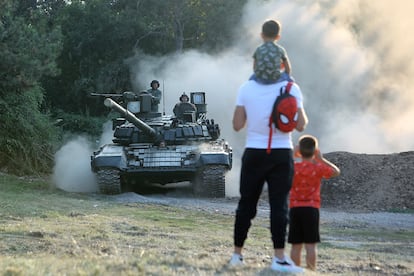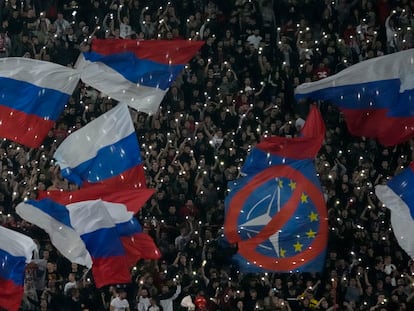Military service returns to the heart of the Balkans: Croatia and Serbia to reintroduce conscription
The Croatian government plans to enlist men for two months and the Serbian government for 75 days. Authorities in both countries plan to start recruiting in 2025


Serbian President Aleksandar Vucic announced on September 14 that he will reintroduce compulsory military service for men — abolished in 2011 — starting next year and with a duration of 75 days. On the other side of the border, Croatia — which suspended military service in 2008 — announced in August through its Minister of Defense Ivan Anusic that a two-month service for men will be reinstated starting January 1, 2025. Croatia, with 3.8 million inhabitants, and Serbia, with 6.6 million, fought a war between 1991 and 1995, after Croatia unilaterally declared independence from the Socialist Federal Republic of Yugoslavia.
Since then, relations between the two countries have been far from warm. Several experts consulted do not see any danger of confrontation in these measures, but instead a clear reflection of the upheavals that the Balkans are experiencing. For different reasons — more closely linked to the uncertainty arising from the war in Ukraine — various European countries are strengthening their defense sectors and reviewing their military service models, including Germany.
Florian Bieber, a professor of South-East European Studies at the University of Graz in Austria, told EL PAÍS via WhatsApp that the Serbian government’s move is above all “a symbolic gesture to stir up nationalist sentiments.” The researcher sees it as a project “symptomatic of rising tensions in the region.” Bieber believes that Belgrade is seeking to “increase citizens’ ties to the army and symbolically remilitarize society.” The analyst recalls that the move is being made in a context of “growing Serbian nationalist rhetoric, particularly with regard to Kosovo, but also in terms of support for the Republika Srpska (a Bosnian Serb entity recognized in 1995 as part of Bosnia and Herzegovina).”
Croatia has been a member of NATO since 2009 and is governed by a coalition government led by Prime Minister Andrej Plenkovic and his conservative party, the Croatian Democratic Union (HDZ), in coalition with the far-right Homeland Movement (DP). In Serbia, President Vucic is leading the country for a second consecutive term, where the conservative Serbian Progressive Party (SNS) has no opposition to overshadow it in Congress.
Serbian researcher Katarina Djokic from the Stockholm International Peace Research Institute (SIPRI) explains via video link that Croatian conservatives always use the issue of improvements in the army as an electoral strategy. And the armies of both countries have been pressuring their governments for years to reintroduce military service. “Voluntary service,” Djokic adds, “has not produced a sufficient number of reservists in either Croatia or Serbia. Fewer and fewer young people want to join the ranks, especially since the war in Ukraine. And this is a phenomenon that is also being seen in other European countries.”
Lack of professional soldiers
Djokic doubts that Croatia and Serbia have enough officers to train the new recruits. “Maybe it is because of the lack of personnel that they have planned such a short period of military service. Maybe it is the maximum they can afford: two months or 75 days.”
Miroslav Aleksic, a member of parliament and leader of the opposition People’s Movement of Serbia (NPS), called the government’s announcement “propaganda.” “There is no strategic thinking here, only recklessness, populism, marketing […] I did my military service in barracks, I know what it is like, the training lasted six months. I don’t understand how you can train someone in 75 days to handle the sophisticated military equipment that we are told about every day,” he told local media outlet Glas Sumadije in September.
Aleksic added that the real question is whether the country is preparing for war. “If so, with whom and why?” he asked. The opposition leader also stated: “If we started the process of professionalizing the army, why have we reached a situation where professional soldiers are leaving the army? It seems to me that they were guided by the logic that Serbs love the army and that it is good for young people.”
Vuk Vuksanovic, a senior researcher at the Center for Security Policy in Belgrade, is skeptical that the measures will come into force in both Croatia and Serbia. He believes that in both cases it may be a ploy by the governments to divert attention from other, more pressing issues. “Both countries have failed to build a more attractive army for young people. In Serbia, many professionals are leaving the institution because of low salaries, corruption, and nepotism. Compulsory service would only serve to paper over the cracks. And neither government has presented a serious project on the cost,” he says via video call.
Vuksanovic said that the Serbian authorities are trying to divert attention from the two main problems facing the country, namely the lithium mining project, which has caused a number of protests among the population, and the situation of the Serbs in northern Kosovo.
“Nobody wants another war against NATO”
A Serbian NGO member with experience in security policy, who asked to remain anonymous, said that since the abolition of military service in 2011, successive defense ministers have repeatedly announced their intention to reintroduce it. “And this time it seems that the government has taken the Croatian initiative as the perfect excuse not to be left behind.” The same source does not believe that militarization will degenerate into war. “Tackling Croatia, or even Kosovo, would be tackling NATO. And nobody in Serbia wants another war against NATO. I think the government’s aim is to keep the population united. But at the same time, the measure could create more instability in the region.”
In 2021, Croatia announced the purchase of 12 second-hand Rafale fighter jets from France for almost $1.1 billion. Last August, the Serbian president doubled down and also announced the purchase of another dozen Rafale fighters from France. But this time, brand new aircraft worth $2.95 billion.
While Croatia condemned the invasion of Ukraine and joined the sanctions imposed by the West, Serbia has avoided imposing sanctions on Moscow but supports Ukraine’s territorial integrity. “The two countries,” explains Djokic, “look at each other and make decisions based on what the other does.” Vuksanovic explains that while Serbia likes to play the role of former Yugoslav leader Josip Broz Tito, “seeking balance between Eastern and Western powers, Croatia sometimes likes to present itself as an overly loyal member of NATO.”
Dimitar Bechev, an analyst at the Carnegie Endowment for International Peace, also argues via email that the Serbian government is playing it cool. “Vucic is flexing his muscles to burnish patriotic credentials. Perhaps he is trying to indoctrinate the youth. As for Croatia, they are reacting to NATO’s requests to increase defense spending to 2% of GDP [Croatia’s contribution to the organization this year is 1.81%].”
Jasmin Mujanovic, a researcher at the New Lines Institute, points out via WhatsApp that both countries have developed “a slow but systematic build-up of weapons” over the past decade and the introduction of compulsory military service is only “the latest evolution of this process.” Mujanovic points out that both countries have “strong political ambitions” against neighboring states. “In the case of Serbia, against Bosnia and Kosovo. And in the case of Croatia, unfortunately, also Bosnia. I don’t think anyone thinks that Croatia or Serbia will invade Bosnia imminently. But I certainly don’t think that the people of Sarajevo and Bosnia will feel very comfortable with these measures.”
Sign up for our weekly newsletter to get more English-language news coverage from EL PAÍS USA Edition
Tu suscripción se está usando en otro dispositivo
¿Quieres añadir otro usuario a tu suscripción?
Si continúas leyendo en este dispositivo, no se podrá leer en el otro.
FlechaTu suscripción se está usando en otro dispositivo y solo puedes acceder a EL PAÍS desde un dispositivo a la vez.
Si quieres compartir tu cuenta, cambia tu suscripción a la modalidad Premium, así podrás añadir otro usuario. Cada uno accederá con su propia cuenta de email, lo que os permitirá personalizar vuestra experiencia en EL PAÍS.
¿Tienes una suscripción de empresa? Accede aquí para contratar más cuentas.
En el caso de no saber quién está usando tu cuenta, te recomendamos cambiar tu contraseña aquí.
Si decides continuar compartiendo tu cuenta, este mensaje se mostrará en tu dispositivo y en el de la otra persona que está usando tu cuenta de forma indefinida, afectando a tu experiencia de lectura. Puedes consultar aquí los términos y condiciones de la suscripción digital.
More information
Archived In
Últimas noticias
Most viewed
- Sinaloa Cartel war is taking its toll on Los Chapitos
- Reinhard Genzel, Nobel laureate in physics: ‘One-minute videos will never give you the truth’
- Oona Chaplin: ‘I told James Cameron that I was living in a treehouse and starting a permaculture project with a friend’
- Why the price of coffee has skyrocketed: from Brazilian plantations to specialty coffee houses
- David King, chemist: ‘There are scientists studying how to cool the planet; nobody should stop these experiments from happening’










































